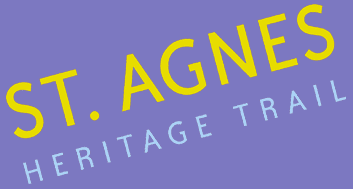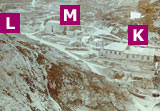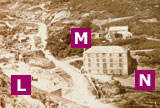
Walk 2 - St Agnes Beacon
 On your left as you walk along the flat track from the steps are the remains of 'hutches' - stone bins where copper ore
was stored before being shipped to Wales for smelting. Along this stretch of cliff were a coal-yard, stables and horse whims
which served the gantries, beneath which 'kibbles' (buckets, or in this case, iron braced wood boxes) containing coal and
other goods were raised and lowered H. The harbour was the focus for Regattas and The Royal Cornwall Gazette of 1839
records that a showman 'Sam the Jumper', dived from one of the gantries into the harbour in front of three thousand people.
On your left as you walk along the flat track from the steps are the remains of 'hutches' - stone bins where copper ore
was stored before being shipped to Wales for smelting. Along this stretch of cliff were a coal-yard, stables and horse whims
which served the gantries, beneath which 'kibbles' (buckets, or in this case, iron braced wood boxes) containing coal and
other goods were raised and lowered H. The harbour was the focus for Regattas and The Royal Cornwall Gazette of 1839
records that a showman 'Sam the Jumper', dived from one of the gantries into the harbour in front of three thousand people.
The second house on your left was used as offices for a shipping business. On your right the first cottage housed a weighbridge and another is on the site of the 'Ship and Castle Inn'.
 Look over the wall opposite the cottages; if the tide is low enough you will see an area of tumbled granite blocks which are
all that remains of the harbour I. St. Agnes Museum has an excellent scale model of the harbour and also possesses one
of two cannons which faced out to sea from the cliff. The museum also has on display the beautiful figurehead from the
schooner the ' Lady Agnes' J which was one of four ships built in the 1870s at the top of the beach in Trevaunance Cove.
Look over the wall opposite the cottages; if the tide is low enough you will see an area of tumbled granite blocks which are
all that remains of the harbour I. St. Agnes Museum has an excellent scale model of the harbour and also possesses one
of two cannons which faced out to sea from the cliff. The museum also has on display the beautiful figurehead from the
schooner the ' Lady Agnes' J which was one of four ships built in the 1870s at the top of the beach in Trevaunance Cove.
 Look at the cliffs above the beach; on the edge are spoil heaps from Wheal Kitty mine. Walk to the bottom of the track. On
your left, in the Local Improvement Committee car park area there were buddles (circular pits used for separating tin from
the crushed ore), a burning house and a shed containing equipment for extracting tin from sand and slimes, and waterwheels
working stamps which crushed the tin ore K.
Look at the cliffs above the beach; on the edge are spoil heaps from Wheal Kitty mine. Walk to the bottom of the track. On
your left, in the Local Improvement Committee car park area there were buddles (circular pits used for separating tin from
the crushed ore), a burning house and a shed containing equipment for extracting tin from sand and slimes, and waterwheels
working stamps which crushed the tin ore K.
 The Driftwood Spars Hotel L on the left appears on the 1841 tithe map as a warehouse and fish cellars, used by the
harbour and the 'Good Intent' pilchard
seine company. In the 1930s it was
renovated and became a hotel. It was used
during the war for the billeting of troops
and displaced families and after the war
became a public house.
The Driftwood Spars Hotel L on the left appears on the 1841 tithe map as a warehouse and fish cellars, used by the
harbour and the 'Good Intent' pilchard
seine company. In the 1930s it was
renovated and became a hotel. It was used
during the war for the billeting of troops
and displaced families and after the war
became a public house.
 Turn right opposite the Driftwood and face the steep slope of Rocky Lane. On the right is a tall building converted
from a store for ropes, wires and chains used in ships M. In front of it on the corner where the picnic tables are, was a
brick kiln N.
Turn right opposite the Driftwood and face the steep slope of Rocky Lane. On the right is a tall building converted
from a store for ropes, wires and chains used in ships M. In front of it on the corner where the picnic tables are, was a
brick kiln N.
Start the steep climb; this area is known as Repper's Coombe. Here on the left where the car park now is, there were water-wheels, stamps, buddles, and a burning house. Eddie Tredinnick noted (Journal No 11 St. Agnes Museum Trust) that often the stamps worked day and night. The noise can only be guessed at.
Wheal Friendly
 After a bend in the lane, look out for the sign 'Wheal Friendly Chalets' on the left. Turn left into the lane to the
chalets but after 30 metres turn right and climb some rough steps by the side of an iron pole. In the course of the
path up the steep hillside you will pass the remains of concrete buildings and a spoil heap, connected with the working
of Wheal Friendly mine P.
After a bend in the lane, look out for the sign 'Wheal Friendly Chalets' on the left. Turn left into the lane to the
chalets but after 30 metres turn right and climb some rough steps by the side of an iron pole. In the course of the
path up the steep hillside you will pass the remains of concrete buildings and a spoil heap, connected with the working
of Wheal Friendly mine P.
On the left at the top of the slope is the engine house which housed a 60" pumping engine. On the right are high walls which retained the mine reservoir, and next on the right is a restored building - now a dwelling- which was probably the miners' 'dry'. Records show that between 1823-5 the mine produced 160 tons of 10% copper ore and between 1855-95, 440 tons of 'black tin'.
 Walk 1 - St.Agnes Village Trail
Walk 1 - St.Agnes Village Trail Walk 2 - St Agnes Beacon
Walk 2 - St Agnes Beacon Walk 3 - Porthtowan, Banns Vale, Mount Hawke and Chapel Porth
Walk 3 - Porthtowan, Banns Vale, Mount Hawke and Chapel Porth Walk 4 - Wheal Rose, The Poldice Plateway and Mawla
Walk 4 - Wheal Rose, The Poldice Plateway and Mawla Walk 5 - Mount Hawke
Walk 5 - Mount Hawke Walk 6 - Mithian
Walk 6 - Mithian Walk 7 - Wheal Coates, Chapel Porth, Wheal Lawrence Valley and Goonvrea
Walk 7 - Wheal Coates, Chapel Porth, Wheal Lawrence Valley and Goonvrea Walk 8 - Water Lane, Wheal Butson and Jericho Valley
Walk 8 - Water Lane, Wheal Butson and Jericho Valley Walk 9 - Jericho Valley and Cross Coombe
Walk 9 - Jericho Valley and Cross Coombe Walk 10 - Blackwater
Walk 10 - Blackwater
